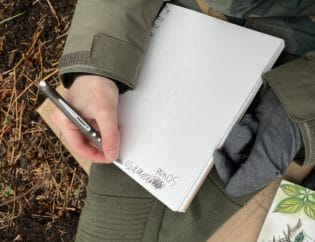
It's not the most glamorous topic but scat, or poop left behind by an animal, is actually a pile of information. Learning to identify scat is a valuable skill for anyone who wants to know the wildlife they share the wild with.
To be a good nature detective, you have to keep your eyes, ears and even your sense of smell open for any sign left behind. Wildlife scientists and other wildlife experts can get a bunch of interesting information from an unassuming pile of poop. Just by looking at a mound of scat, some nature experts can tell when it was left behind, what's in it and then identify the animal and eventually pinpoint its location. But the best interpreters of scat are other animals. Scat gives them crucial information on the species, sex, age, health and sexual maturity of its source.
Where to find scat. That's easy. Where animals like to hang out, which is often where animals like to eat, though sometimes animals mark their territory with scat and urine.
 How to identify scat. Just take a good field guide with you, or else our handy field sheet to North American wildlife scat if that's where you live. Get a good look but please don't touch scat with your hands unless you have a good pair of rubber gloves on. Or use a stick to examine it and wash your hands after. Animal feces can pass along parasites and diseases.
How to identify scat. Just take a good field guide with you, or else our handy field sheet to North American wildlife scat if that's where you live. Get a good look but please don't touch scat with your hands unless you have a good pair of rubber gloves on. Or use a stick to examine it and wash your hands after. Animal feces can pass along parasites and diseases.
Here are some tips for identifying the "culprit":
Look for signs of what the animal has been eating. Bear scat could have berries in it. Fox and coyote scat could have hairs and bones from prey the animals have eaten, as well as berries or insects.
Wintertime rabbit scat looks like small balls of sawdust, from their winter diet of twigs and bark.
Pellets from owls and hawks are sometimes confused with scat. They are the undigested fur and bones from the small mammals eaten by these birds of prey, coughed up in a neat little package.
The scat of herbivores is more compact and geometric, like the rounded pellets made by deer and rabbits.
The size of scat is proportional to the size of the animal that produced it, so those deer pellets will be smaller than what's produced by a moose.
Scat Fact! Wombats are the only creatures to poop in square shapes! Researchers figured out that the varied elasticity of the intestines of the wombat help to sculpt the poop into cubes. The marsupial then stacks the cubes - the higher the better so as to communicate with and attract other wombats. Just wow!

Need more scat in your life? You can purchase a bucket of scat replicas from Enasco right here.












Black, tubular, ringed, scat in our back yard, 3/4 to 1 inch in diameter. We live on a hill at 700 ft in Camas, WA. Could it be a bear cub on it’s own? We have raccoons, possums, and bunnies but this doesn’t match any of their scats.